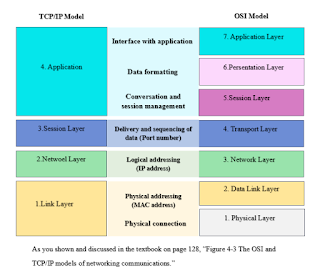Week Six: Internet Protocol version Six (IPv6).
This
week six topic focused on the fundamental concepts of Internet Protocol version
six (IPv6), describing IPv6 practices, and the implementation of Pv6 in a
Transmission Control Protocol/ Interprotocol (TCP/IP) network design. The Internet
Protocol version four (IPv4) was developed for the purpose of assigning Internet
Protocol addresses. IPv4 was developed to handled IP addresses for the foreseeable
future, unfortunately, it turned out that wasn’t the case as the traffic (more computers
became available in homes and smaller businesses) on the air wave begin too
much to handle.
The IPv6 was developed as the replacement for
IPv4. IPv6 comes with tremendous benefits that IPv4 didn’t had, and one of
those benefits that IPv6 come with has to do with its pool of unlimitedly IP
address. IPv4 is stay in used at this current moment as IPv6 translation begin
slowly into replacing IPv4. There is no comparison whatsoever between IPv4 and
IPv6 in this current moment and in the future because it’s a matter of time for
IPv4 to be in the review mirror. IPv6 wasn’t just developed to extend IP
addresses alone, but also to strengthen “security by making the Internet
Protocol Security (IPsec) protocol support a standard part of every IPv6 stack.”
This
doesn’t mean that IPsec must be use, but it is a standard that has been
recommended for all manufactures to support IPsec just in case a user decide to
use it. Moreover, the benefit for using IPsec is that every data (packet) you
send out from your system are going to be secure (encrypted). The following
show the difference in IP addressing between IPv6 and IPv4: an IPv4 address is
written using four octets separated by three periods as follow:192.198.1.5),
and meanwhile an IPv6 is a combinations of digits and letters and it’s consist
into eight groups and separated by eight colons as follow: 2301:5d10:2j11:5f20:j16e:mtf1:3356:6df7.
“Octets are done” since IPv6 has 128-bits of IP addresses.
There
is not guarantee that IPv6 won’t turned to be as IPv4 has because as the world
population grow – which means one thing, more computers. The question that
developers and the public should be asking is that will IPv6 be able to handle
the IP addressing in the nearer future as it was once thought of with IPv4? The
needs for more IP addresses come when more and more computers become available to
90 percent of the world population.

Comments
Post a Comment